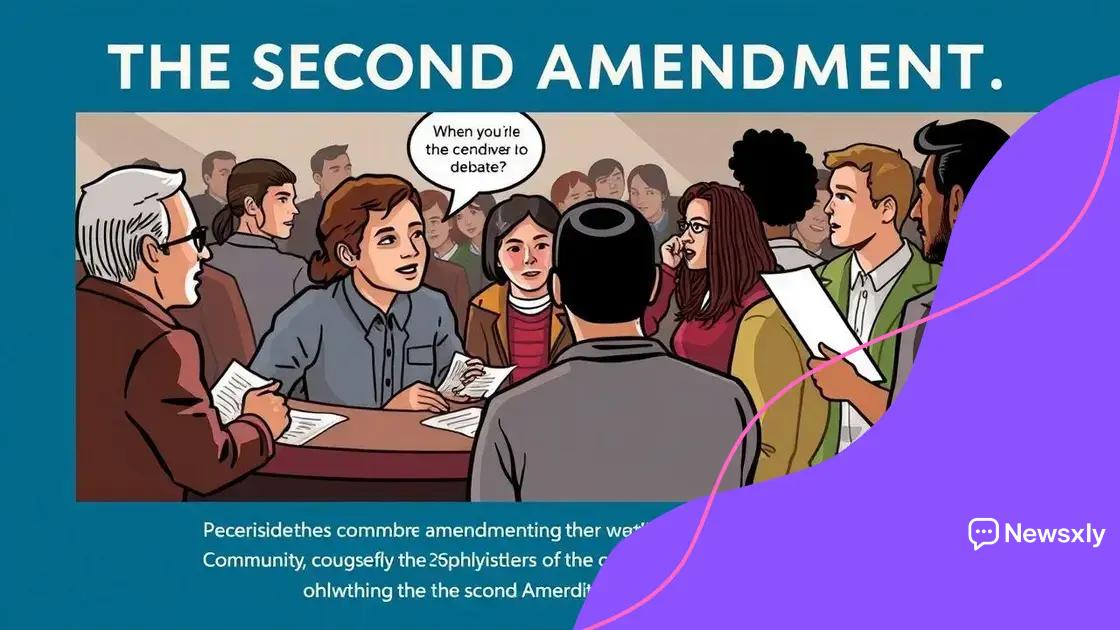The ongoing debate over gun control: what you need to know

The ongoing debate over gun control encompasses key issues such as public safety, individual rights, and legislative measures, with diverse opinions shaped by demographic factors and changing public sentiment.
The ongoing debate over gun control is one that affects us all, whether we realize it or not. With varying opinions and heated discussions, it’s important to dive into the details and understand the implications of this issue. What do the statistics say? Let’s explore.
Understanding the gun control debate
Understanding the gun control debate is essential for anyone interested in issues surrounding safety and rights. This topic stirs strong emotions on all sides and affects everyone in society. By exploring different angles, we can better grasp the complexities involved.
Key Issues in Gun Control
The debate often centers on a few key issues. These issues include public safety, individual rights, and the effectiveness of laws in reducing violence. Many argue that stricter laws could help reduce gun-related incidents.
- Impact of gun control laws on crime rates
- Cases of responsible gun ownership
- Differences in state regulations
- Public perceptions of gun violence
On the other hand, many believe that gun control infringes on personal freedoms. They argue that responsible gun owners should not lose their rights due to the actions of a few. This perspective emphasizes the importance of self-defense and constitutional rights.
The Role of Statistics
Statistics play a crucial role in shaping opinions on this topic. Data showing high rates of gun violence can sway public sentiment toward supporting stricter measures. Alternatively, statistics highlighting effective self-defense incidents can bolster the argument for personal rights.
When analyzing these statistics, it’s important to view them critically. Not all data represents the complete picture, and it’s vital to look at trends over time rather than isolated incidents. Understanding how various factors contribute to gun violence can provide better insight into potential solutions.
- Common misconceptions about gun violence
- Statistics associated with different demographics
- The correlation between gun ownership and crime rates
Ultimately, engaging with this debate requires an open mind. By listening to diverse viewpoints and considering the facts, we can begin to explore effective approaches to this complex issue.
Key statistics on gun violence
Key statistics on gun violence help illuminate the current state of this critical issue. Understanding these numbers is vital for informed discussions about gun control policies. From national surveys to local studies, statistics reveal trends and patterns that can shape opinions and legislation.
National Trends
Across the United States, gun violence has become a pressing concern. According to data, thousands of people lose their lives or are injured each year due to gun-related incidents. These statistics highlight the urgency of addressing this issue.
- In 2021 alone, over 48,000 gun-related deaths were reported.
- Firearm homicides account for a significant portion of overall homicide rates.
- Mass shootings have increased in frequency over the last decade.
- Suicides make up a majority of gun-related deaths.
Examining specific demographics can also provide deeper insights. Certain groups are disproportionately affected by gun violence, making it crucial to examine the data from various angles. For example, young males in urban areas often experience higher rates of gun violence compared to other demographics.
Regional Disparities
Gun violence is not uniform across the country. Different regions report varying rates, influenced by factors such as population density, local laws, and socioeconomic conditions. Understanding these regional disparities can shed light on why some areas struggle more than others with gun-related issues.
- Urban areas generally have higher rates of gun violence than rural areas.
- States with stricter gun laws often report lower incidents of gun violence.
- Economic factors can contribute significantly to rates of violence.
These statistics not only underline the problem but also serve as a foundation for any discussions surrounding potential solutions. Engaging with this data allows for a more informed debate on the best pathways forward in addressing gun violence and improving safety for all.
Different perspectives on the Second Amendment

Different perspectives on the Second Amendment highlight the ongoing debate about gun rights and regulation in the United States. This amendment grants citizens the right to bear arms, but its interpretation can vary widely depending on individual beliefs and values.
The Right to Bear Arms
Many supporters of the Second Amendment argue that it is essential for personal freedom and self-defense. They believe that responsible gun ownership empowers individuals to protect themselves and their families. This group often emphasizes the historical context of the amendment, arguing that it was created to prevent tyranny and ensure freedom.
- The Right to Self-Defense: Owning a firearm is seen as a necessary means of protecting oneself.
- Historical Importance: Advocates contend that the Second Amendment is crucial for maintaining personal liberties.
- Community Defense: Many argue that armed citizens can help deter crime.
However, there are also strong arguments for regulating gun ownership. Opponents of unrestricted gun rights emphasize the need to reduce gun violence and enhance public safety. They contend that common sense restrictions can protect individuals while still respecting the rights granted by the Second Amendment.
Arguments for Regulation
Those advocating for stricter gun laws often point to the alarming rates of gun violence in the U.S. They argue that effective regulation could significantly reduce these incidents. This includes background checks, restrictions on certain types of firearms, and improved mental health evaluations.
- Safe Storage: Advocates for regulation often call for laws requiring secure storage of firearms.
- Background Checks: Implementing universal background checks can help prevent guns from falling into the wrong hands.
- Focus on Mental Health: Addressing mental health issues can reduce firearm-related incidents.
These varying perspectives on the Second Amendment are central to the broader conversation about gun control, highlighting the need for nuanced discussions that consider all viewpoints. Engaging with each side’s arguments can pave the way for more effective solutions that respect both rights and public safety.
Legislative measures and their impacts
Legislative measures concerning gun control play a crucial role in shaping the landscape of gun ownership and public safety. Various laws have been enacted over the years, aiming to reduce gun violence while respecting the rights of legal gun owners.
Key Legislative Measures
Several important laws have significantly impacted gun control across the United States. These laws vary from state to state and often spark intense debate among citizens and lawmakers alike. Among the most notable are:
- Background Check Laws: Many states have implemented mandatory background checks for all gun purchases to prevent criminals from obtaining firearms.
- Assault Weapons Ban: This law restricts the sale and possession of certain types of firearms deemed to be more dangerous.
- Red Flag Laws: These laws allow law enforcement to temporarily remove guns from individuals deemed a threat to themselves or others.
These legislative actions reflect ongoing attempts to balance individual rights with community safety. Supporters argue that these measures are essential for reducing gun violence, while opponents often claim they infringe upon personal freedoms.
Impacts of Legislative Measures
The impacts of these laws can be seen in various metrics related to gun violence. For example, states with stricter laws frequently report lower rates of gun homicides and suicides. However, the effectiveness of these measures remains a hot topic in public discussions.
- Statistical Evidence: Research shows that states with comprehensive background checks have fewer instances of gun violence.
- Community Safety: Legislative measures can create safer environments, especially in urban areas with higher crime rates.
- Public Perception: Laws can shape how communities view gun ownership and safety, influencing societal norms.
While some measures appear to lead to positive outcomes, challenges remain in effectively enforcing these laws and addressing illegal gun trade. The dialogue around such legislative actions continues to evolve, as new data and incidents shape public opinion and influence future policies.
Public opinion trends on gun control
Public opinion trends on gun control can provide valuable insights into how communities view this important issue. Over the years, surveys and polls have indicated changing attitudes toward laws and regulations related to firearms.
Shifts in Public Sentiment
Recent years have shown a shift in public sentiment regarding gun control. Following high-profile shootings, many Americans have expressed increased support for stricter gun laws. These emotions often translate into calls for action from lawmakers. Key factors influencing these trends include:
- High-profile incidents of gun violence.
- Media coverage and public discussions about safety.
- The influence of advocacy groups on both sides of the debate.
As more incidents occur, a significant portion of the public may feel a sense of urgency to re-evaluate current laws. This response often leads to a spike in support for measures aimed at increasing safety.
Demographic Differences
Public opinion on gun control varies greatly across different demographics. Factors such as age, location, and political affiliation can all play significant roles in shaping attitudes. Younger individuals, for instance, tend to favor stricter regulations compared to older generations. Moreover, urban residents often advocate for more stringent laws than those living in rural areas.
- Young people show strong support for gun reform.
- Urban voters often prioritize safety over gun rights.
- Political affiliation strongly influences individual perspectives.
Understanding these demographic trends can be crucial for lawmakers as they draft policies that reflect the desires of their constituents. Engaging various communities allows for more comprehensive discussions about appropriate measures to address gun violence.
FAQ – Frequently Asked Questions about Gun Control
What is the Second Amendment?
The Second Amendment to the United States Constitution protects the right of the people to keep and bear arms.
How does public opinion influence gun control laws?
Public opinion can significantly impact lawmakers, leading to changes in legislation based on the demand for stricter or looser gun regulations.
What are common legislative measures related to gun control?
Common measures include background checks, restrictions on certain firearms, and red flag laws aimed at preventing potential harm.
Why is it important to understand demographic differences in gun control opinions?
Understanding demographic differences helps policymakers address the unique concerns and needs of various communities regarding gun ownership and safety.





